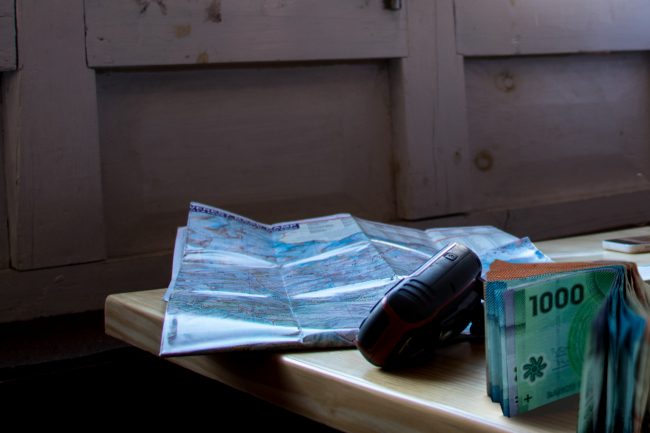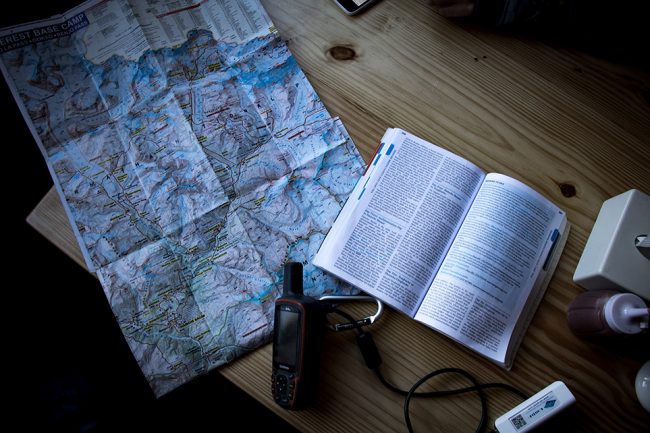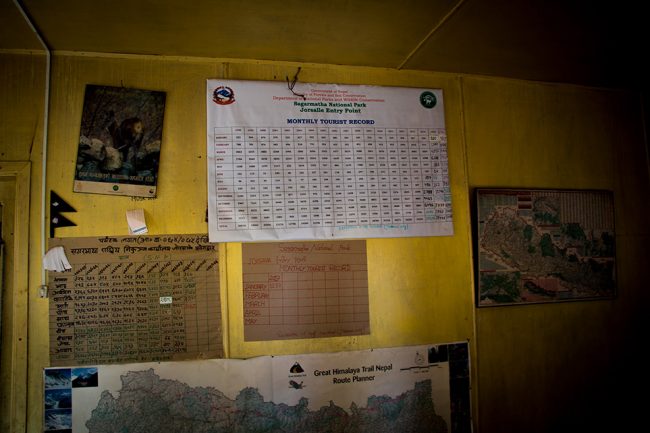Everest Base Camp
Ultimate Guide to trekking independently

It was MoMos night, and we were sitting outside at the Yak and Yeti restaurant in Vienna. It was one of those fine fall evenings with a lovely breeze, but you could feel winter was around the corner. Still indecisive, we were trying to plan a midwinter escape for the beginning of February but had no clue where to go. After our second plate of MoMos the decision was crystal clear: Nepal; hiking the Everest Base Camp Trek.
Planning an adventure can be tricky. For us, hiking the Everest Base Camp Trek was a no-brainer. We decided we wanted to go and we just went without too much forward planning.
The question of trekking independently or not was solely a moral one of whether to support a guide or not. A group hike was out of the question. We love trekking individually, carry our bags, take a break whenever we want to, and we were confident to trek the EBC trek alone. So that’s what we did.
The organization process was easy, and we never ran into much trouble. We collected our experience for you; below you can find some tips that will make your journey peaceful, a little less daunting and as smooth as possible.

Why Go?
There is no doubt: the best way to visit Nepal is on foot, with its networks of trails formed over centuries by porters, locals, and mountaineers. There lies a happy place, wandering from teahouse to teahouse, taking in the breathtaking beauty of 8000m peaks and the silence of a crystal clear sky.
Although Nepal was severely damaged following the 2015 earthquake, most trails, including the Everest region, escaped the worst and are safe to trek. The country itself encourages travelers to visit the magnificent and bustling land of Nepal and to support them this way as they attempt to rebuild.
A decision bonus: You can hike the Everest Base Camp Trek without too much planning ahead. Permits are easy to organize and accommodation and food lines up on the way.
So if you have ever longed to walk in the shadows of the most magnificent mountains on Earth to finally see the top of the world from a stone’s throw away, this is the trek.


The Everest Base Camp Trek
Duration: 12 to 20 days
Maximum elevation: 5.545m
Start: Lukla
Finish: Lukla
Permits: TIMS card, Sagarmatha National Park ticket
Costs: $500+

Trek stages
Our trek stages to the Everest Base Camp.
Click the days for more information and stories from along the way.

Day 1: Lukla to Phakding
Distance: 7.8 km
Ascent: 305 m
Descent: 464 m
Max Elevation: 2866 m
Day 2: Phakding – Namche Bazaar
Distance: 11.7 km
Ascent: 1135 m
Descent: 312 m
Max Elevation: 3418 m
Day 3: Acclimatization Day
Namche Bazaar – Khunde – Namche Bazaar
Hike: 5.4 km
Ascent: 508 m
Descent: 352 m
Max Elevation: 3875 m
Day 4: Namche Bazaar – Tengboche
Distance: 10.6 km
Ascent: 852 m
Descent: 439 m
Max Elevation: 3845 m
Day 5: Tengboche-Dingboche
Distance: 10.8 km
Ascent: 724 m
Descent: 273 m
Max Elevation: 4302 m
Day 6: Acclimatization Day
Dingboche – Chukung – Dingboche
Hike 7.8 km
Ascent: 387 m
Descent: 387 m
Max Elevation: 4683 m
Day 7: Dingboche – Dugla
Distance: 5.4 km
Ascent: 365 m
Descent: 82 m
Max Elevation: 4610 m
Day 8: Dugla – Lobuche
Distance: 3.3 km
Ascent: 344 m
Descent: 19 m
Max Elevation: 4934 m
Day 9: Lobuche – Gorak Shep – EBC – Gorak Shep
Hiking 12.6 km
Ascent: 836 m
Descent: 584 m
Max Elevation: 5277 m
Day 10: Gorak Shep – Pangboche
Hiking 17.9 km
Ascent: 242 m
Descent: 1436 m
Max Elevation: 155 m
Day 11: Pangboche – Monjo
Hiking 23.4 km
Ascent: 249 m
Descent: 1334 m
Max Elevation: 3859 m
Day 12: Monjo – Lukla
Hiking 7.3 km
Ascent: 407 m
Descent: 164 m
Max Elevation: 2846 m

Trekking safety tips
- Drink lots of water
- Never skip acclimatization days
- Listen to signs of altitude sickness
- trek higher, sleep lower
- Always pack an emergency supply of food, water, and warm clothes
- Bring a map and a whistle
- Get an adequate health and evacuation insurance (this is not just smart to have in case of an emergency, you’ll also need to provide your insurance information to register your TIMS Card!)
- Don’t rush, look around and enjoy


Getting to Lukla
There are two ways to get to Lukla. If you have enough time and trekking energy on your hand, you can trek in and out from Shivalaya, which takes six days. You will have the trek mostly to yourself and can acclimatize slowly.
Lukla airport serves as the main access point to visit the Khumbu region. We took a flight from Kathmandu to the Tenzing–Hillary airport, also known as Lukla, or: the world’s most dangerous airport. Let me tell you; it’s quite the flight! Its runway is only 1,729 ft long (with a 12% gradient) and abruptly drops off to a 9,200ft cliff edge. Flights are often canceled due to bad visibility.

Condition of the trails
Although they can get pretty steep – which you will first get to know on your way up to Namche – the trails are in great condition, clear and easy to follow. We did bring a GPS, but we only used it to document some fun facts (speed, altitude, distance to destination). It’s almost impossible to get lost on the trail. However we did accidentally take a shortcut on our way to Dingboche (Day 5), that wasn’t too much fun with heavy backpacks. But for me personally, the most difficult day was the trek to Gorak Shep and Everest Base Camp. I am not good with small loose rocks, and the wind that day was so strong, that at times we couldn’t see each other standing two feet apart.



Accommodation
The Everest trek offers great flexibility to walk as far as you want to. You will likely cross a lodge or teahouse every hour or two, great to take a tea break, eat some MoMos or just call it a day, but don’t be too spontaneous, take the altitude into account, and try to sleep lower than you hiked that day.
Accommodations are usually very basic, wooden rooms. Few places offer private rooms with an attached bathroom. To warm up, you can find an oven in the common room where you can also charge up on food and recharge your batteries for around $3/battery. Most (if not all) lodges provide WiFi for a surcharge (about $5 an hour/a stay). You will be equipped with blankets; nevertheless, you should bring a sleeping bag as it can get freezing at night. We heard of solar hot showers and buckets of hot water, but in our case (we hiked in February), there was no running water above Namche, and we didn’t waste much thought on the possibility to take a shower.


Eating
The Everest cuisine offers a variety of noodles, potatoes, rice, and vegetables. You can find several meat dishes on the menu as well, but you should seriously consider going vegetarian on the trek. As tempting as a buff burger might sound, due to the no-killing-policy in Sagarmatha National Park, all meat is carried up from below Lukla and is already getting old by the time it would land on your plate. A happy stomach can be gold up in the Himalayas. The local staple is dal bhat (lentil soup with rice and vegetables). Our favorite dish, which we practically had every day: MoMos. Delicious!
As for snacks along the way: most lodges offer pricey Snicker bars. We carried our chocolate and muesli bars all the way from Kathmandu and were always looking forward to that special chocolate break with a view.



Check out our frequently asked questions & Tips on budgeting
Leave a Reply!
Leave a Reply
2 Comments
Leave a Reply
More Tips for the EBC trek







Hi I am thinking about doing this trip next year your video and knowledge that you both have passed on is awesome as I was unsure of doing it now it’s a definite. Thank you both for sharing it planning to bring my Mavic air and GoPro hope that won’t be a problem.Thanks again best wishes for the future.Joe from Ireland.
Hey Joe!
So happy that you decided to go ahead and do the Everest trek! It’s an experience of a lifetime. Send us some pics!
We are going back to Nepal this month as well. Can’t wait!
Thank you so much for your kind words!
Wish you all the best & lots of fun on your adventure!
Bella